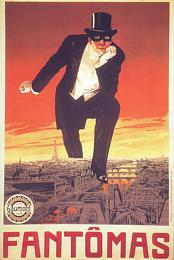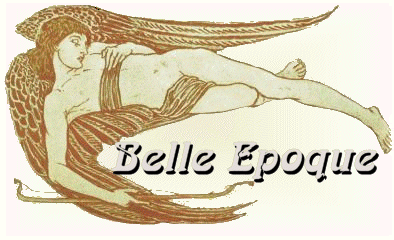The Belle Epoque in Europe
France: The Origin of Cinema
"France" by courtesy of Anita Seth - French 102 - Professeur Monique Saigal
Pomona College, Claremont, California, USA - Spring 1995

The cinema industry was founded during the Belle Epoque in France. The first pioneers were Louis Lumière, Georges Méliès, Charles Pathé and Léon Gaumont. On 28th December 1895, the first paid public performance of motion pictures taken by Louis Lumière's (1864-1948) cinematograph had been held in the Indian Salon of the Grand Café, 14 boulevard des Capucines, in Paris. It was La Sortie des usines Lumière (Leaving off work at Lumière's factory). In spring and summer of that year, Lumière made a lot of such short films he became famous for, e. g. L'arroseur arrosé, Partie d'écarté, Arrivée d'un train à la Ciotat, Barque sortant du port and Repas de bébé. Each film lasted only a minute or even less and showed short scenes in the daily life of a citizen and nothing else. As a matter of fact, Lumière's interest was not in the film itself, but rather in selling his cinematograph. He made his films mainly to make propaganda for his machine but so, unwillingly, he created as well the idea of paid performances for the cinema as he created a way to distribute them. He soon left the Grand Café and got his own theatre. At the end of the 19th century figured 1,424 short films in his lists!
Georges Méliès (1861-1938) originally worked as an illusionist in Robert Houdin's theatre. In 1896, he started to film the conjuring-tricks. One of the most famous is Escamotage d'une dame chez Robert Houdin (The Vanishing of a Lady at Robert Houdin's). Like Lumière, he also made many short films, but instead of showing realistic scenes, he often created fantastic spectacles. Realism and miracles: The two grand axes of cinema are already present with "Lumière du jour" and "Méliès de la nuit"1). Unfortunately, Méliès could not profit by his work because not having the time to distribute his films himself, he depended on others. It was not yet the time of author's rights, so his films were exploited by foreign companies not paying him anything for it.

Charles Pathé (1863-1957), however, had an enormous economic success. In 1908, he controlled a third of the global film market. He was mainly interested in production and commercial aspects. The direction of his films has been made by a series of directors. The first one was Ferdinand Zecca (1864-1947) who initially started as an actor. Léon Gaumont (1864-1946) as well worked basing on the films' economic aspects and let his secretary, Alice Guy (1875-1968), direct his films. In fact, she was the first female director world-wide. Between 1897 and 1906, she has made 301 films!
It is obvious that at that time, the artistic aspect of the films was not of great importance yet. Neither Zecca nor Guy had any experience in performing art when they became director. Cinema was not of importance regarding art but economy: Film making had not to be expensive and the directors had to work quickly. Usually they made one or two films a week. There was neither time nor money for complex or artistic films and the directors were not respected as they are nowadays. The most important object was to make profit by selling the films.
In the early 20th century, however, the genres which we nowadays associate with the beginning of cinema started to develop. More and more the story line of a film became important. Under Zecca's direction, a first version of Quo Vadis (1901) had been made, daily life dramas like Les victimes de l'alcoolisme (1902) and Passion (1902/03). Literature classics served as plots. Albert Capellani (1870-1931) who worked for Pathé was one of the most famous directors for this kind of film. He made L'assommoir (1909) and Germinal (1913) adapted from novels of Emile Zola, Notre Dame de Paris (1911) and Les Misérables (1912) of Victor Hugo. Les Misérables was the longest film of the epoch playing 3 ½ hours!
It was also the beginning of comedies and burlesques. The actor Max Linder (1883-1925) was famous for his comical character in a series of Pathé films, he played his first role in Zecca's film La vie de Polichinelle (1905). André Heuzé was the first director specialising in comedies and created absurd pursuits. Victorin Jasset (1862-1913) started to make detective films basing on short stories from popular newspapers. In 1908, Emile Cohl produced the first animated cartoon, Fantasmagorie.


Still more famous became Louis Feuillade (1874-1925), director at Gaumont's, who started with realistic daily life dramas like in his series La vie telle qu'elle est (1911-13), but his first big success came when he made a series film about the ingenious gentleman-bandit Fantômas (1913/14). He could repeat the success later with series such as Les vampires (1915) and Judex (1916/17).
Although we usually imagine the films of that time black and white and silent, they often were coloured. There existed several techniques to give them colour: the tingeing of the whole film or the handmade painting by tiny pencils. The sound in the theatres was not of high quality but he existed, however. There were also even more exciting events, e. g. Raoul Grimoin-Sanson's "Cinéorama" constructed for the World Fair in 1900: Ten synchronous projectors generated a circular panorama of 360 degrees. The film industry was far more advanced than we imagine today. Paris, however, could not defend its position of being the centre of the cinematic world. The first world war interrupted the French film production whereas meanwhile in Hollywood this industry was born and growing rapidly.
1) "Lumière of the day" and "Méliès of the night", a little play on words where "lumière du jour" means also "daylight".
